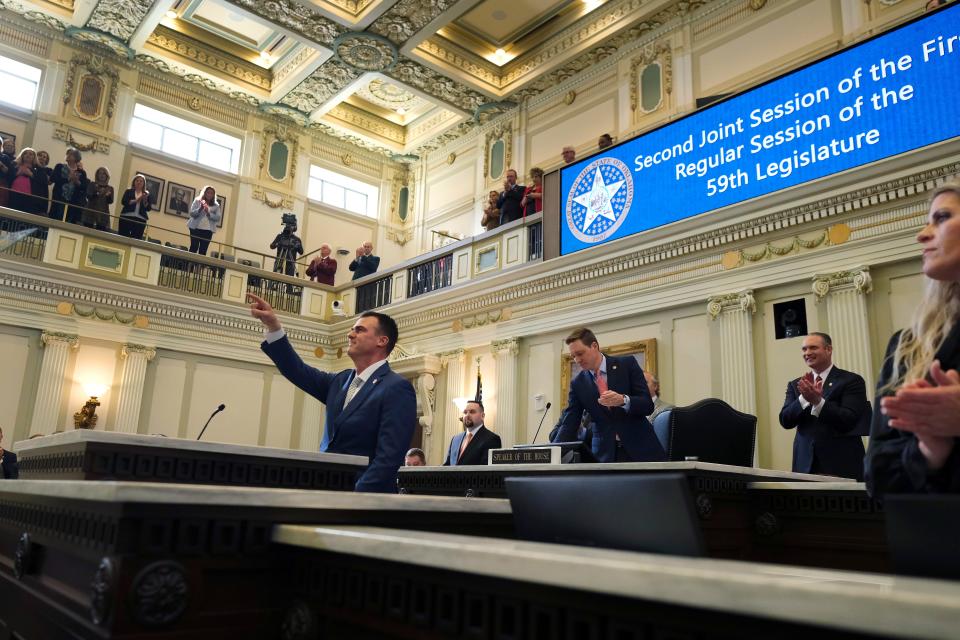Amid high inflation, Oklahoma Gov. Stitt's flat budget proposal could pressure agencies
- Oops!Something went wrong.Please try again later.
Gov. Kevin Stitt has proposed flat budgets at most of the state’s largest agencies, which could force some tough choices as high inflation eats into the money used to provide services.
“Given inflation, a flat budget for (Fiscal Year 2024) for public higher education will have a projected decline in purchasing power of approximately 8.7% from the previous 18-month period,” said Angela Caddell, spokesperson for the state Regents for Higher Education.
The regents are asking the Legislature for a boost next year of 11.9% over its current funding level. Even with that increase, average per-pupil funding for the state system of higher education would remain below the national average, Caddell said.

A spokeswoman for the Oklahoma Department of Transportation cited year-over-year inflation of 7% in road construction inputs but said that increase could be managed. The department’s budget request is about $24 million higher than the governor’s request of $784 million. And a spokesperson for the Department of Human Services said current services could be maintained with a flat budget.
Inflation in a wide range of goods has been running at a rate not seen for decades, though it has slowed in recent months. The Consumer Price Index for All Urban Consumers rose by 6.5% from January, 2022 through December, according to the U.S. Bureau of Labor Statistics.
As the 2023 legislative session opened last week, the governor proposed a budget to lawmakers that would hold most agencies to their current year funding authority, while calling for $656 million in tax cuts and $383 million in education initiatives.
More:Investigation into misspent education funds clouds hearing on budget requests from Walters
“Oklahomans sent a clear message last November when they overwhelmingly voted for our vision: to shrink the size of government, to cut taxes and to let the free market flourish,” Stitt said at his State of the State address. “We need to return excess revenue to the people, not grow government.”
Just a few years removed from budget crises that led to tax hikes in 2018, Stitt and the Legislature have put historic budget surpluses under the mattress, fearful of building too much growth into agencies lest the hard times return.
Still, agency funding has grown.
The Legislature has essentially ignored Stitt’s previous flat-budget requests and boosted funds at major agencies. The Legislature approved $552 million for the Oklahoma Department of Corrections in the current fiscal year, which began July 1; that was up from $486 million in the 2018 fiscal year, when officials warned that the prison system was overcrowded and underfunded.
A spokesperson for the Corrections Department said this week that “we have nothing to share” about next year’s budget request and that the current director, Steven Harpe, has “identified ways to bring efficiencies to its operations and maximize budget effectiveness.”
On top of state increases, federal pandemic aid has meant major infusions of cash. Appropriations for the current fiscal year included nearly $2 billion in American Rescue Plan Act money; that was 16% of the total appropriated funds, according to Stitt’s latest budget.
More:Oklahoma Gov. Stitt, reelected and emboldened, will call for tax cuts and school choice
Budget process just underway
The annual spending bills are typically written late in legislative sessions, which must end in May.
Rep. Ryan Martinez, R-Edmond, the vice-chair of the House Appropriations and Budget Committee, said, “The Legislature has the sole constitutional authority to appropriate the people’s money. This is very early in the budget drafting process, and we are working every day to pass a balanced, responsible budget.”
Martinez said agencies could factor in the impact of inflation to their budget requests.
“I have yet to see a request that asks for more dollars due to inflation,” he said.
House Minority Leader Cyndi Munson, D-Oklahoma City, a member of the Appropriations and Budget Committee, said Thursday that a flat budget “would essentially be a cut” because of inflation.
She said school districts and agencies were confronting higher costs for utilities and rent and other bills.
5 takeaways: Gov. Kevin Stitt pushes tax cuts, school choice in State of the State
“And so we have to be mindful of that,” she said.
She expressed hope that House and Senate budget leaders “would push back on the governor's plan to have a flat budget and instead ensure that we are giving them the funding that they need to pay their bills and that way we can provide critical services to our constituents.”
Kate Vesper, a spokesperson for Stitt, said Thursday, “Even under record high inflation due to President Biden’s failed economic policies, the Stitt administration maintains its priority to provide Oklahoma taxpayers with the best services while being fiscally responsible and maintaining flat budgets.”
Contributing: Staff writer Dale Denwalt
This article originally appeared on Oklahoman: What Oklahoma Gov. Kevin Stitt's budget plan could mean for agencies

